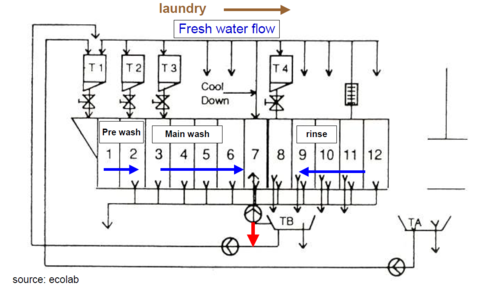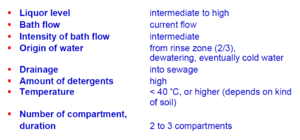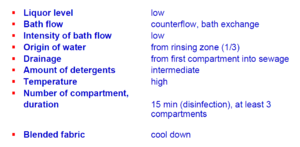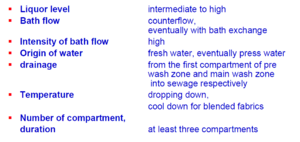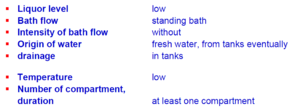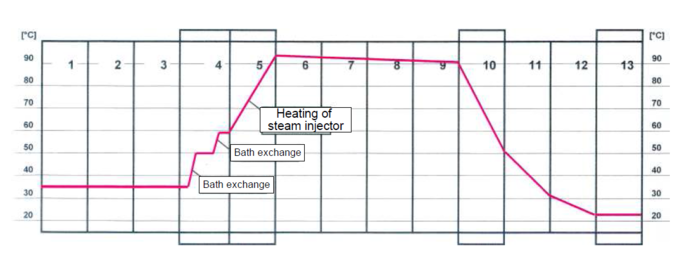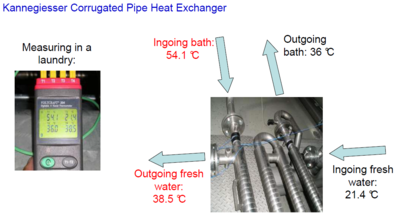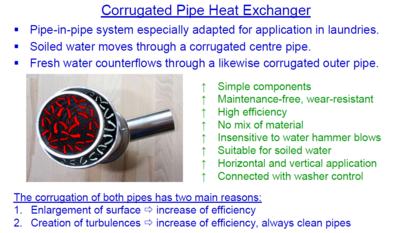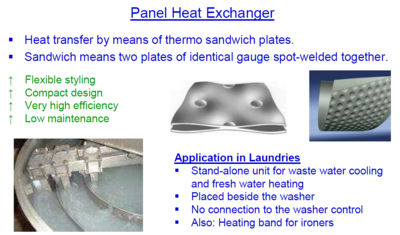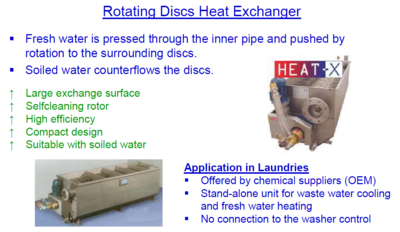Washing of clothes
From Efficiency Finder
Back to EFFICIENCY FINDER OF TEXTILE INDUSTRY
Washer extractors
Washer extractors are applied for
- heavily soiled laundry
- textiles with bleeding colours
- small batches
- high quality workware
- infectous laundry
- cleanroom laundry
- medical devices
- sensitive laundry: wool blankets, curtains
- special laundry items (e.g. mattresses)
- wet clean
Design of the washing program:
- Pre wash
- Main wash
- Rinse with intermediate spin
- Neutralisation, Addition of Aids (starch, textile softener, acid)
- Final spin
Pre washing:
- Rapid wetting of laundry
- Swelling of soil
- Removal of heavy soil from the laundry
- Dissolving and swelling of spots
- Temperature: depends on amount and kind of soil -> blood 20 – 25 °C (> 30°C denaturation/fixing of proteins), fat/oil 50 – 60 °C (> 50°C good soil removal)
- Detergents: 50 – 70 % of total amount (reuse of rinse water increases detergent concentration, residues of peroxide cause denaturation/fixing of blood)
- Drain -> in sewage
Main wash:
- Removal of remaining soil
- Removal of oxidative spots
- Disinfection (thermal) at temperature > 85 °C
- Disinfection (chemical) at 40 °C (depends on disinfectant)
- Increase of textile whiteness
- Duration: approx. 10 – 15 min at temperature level
- Temperature: adapted to washing process and amount and kind of soil (e.g. thermal disinfection = 10 min at 90 °C or 15 min at 85 °C)
- Drain -> in sewage
Rinse:
- Removal of soil residues
- Removal of detergent residues (surfactants, alkali and bleaching agents)
- Duration: (total) approx. 8 – 12 min
- Temperature approx. 60 – 25 °C (without heating), depends on main wash temperature
- Drain in storage tanks
- Inactivation of bleach agents is needed if extracted water is reused
Neutralisation:
- In last rinse
- Reduction of textile pH-value for the purpose of preventing yellowing effect during drying or ironing process
- Duration approx. 2 – 4 min
- Temperature approx. 20 – 25 °C
- Formic or acetic acid in last rinse (recommended pH-values for flatwork 6,0-6,5, for fully dried laundry 6,0-6,5, for garments for tunnel finisher, flat press 5,5-6,5)
Spin:
- Mechanical dewatering by centrifugal force (g - factor up to 600, 5 - 10 min)
- Water content of laundry depends on´type of fabrics, drum, number of revolution (rpm), duration, temperature of laundry
- Intermediate spin between rinsing baths, minimisation of carry over effects of detergent residues in next rinse bath
- Problematic: wrinkling of PES/CO textiles at temperatures > 40 °C,high rpm and/or spin duration
Tunnel washers
Characteristics:
- Continuous washing process
- Counterflow principle: Constantly dilution of liquor
- Corrective: standing bath, bath exchange
- Liquor level nearly not alterable
- Low mechanics (oscillating)
- Diversification of mechanics and cycle time effects all compartments.
Schematics of a tunnel washer:
Number of compartments in a tunnel washer:
- soaking (optional): 1-2
- pre wash zone: 2-4
- main wash zone: 3 -6
- rinsing zone: 2-6
- finishing: 1-2
- dewatering
Parameters:
Pre washing
Main washing
Rinsing
Finish
Distribution of temperature in a tunnel washer
Efficiency measures
Usage of storage tanks for washer extractors:
- Use of water from last in first rinse
- Use of water from rinsing in pre- and main wash
- Last rinse with fresh water quality only
- Savings: Water up to 40 %, Steam up to 45 %, Detergents up to 30 %
- Environmentally friendly
- Economical
- Quick return on investments
Heat recovery:
The hot bath is passed through the heat exchanger and is cooled down. Fresh water is heated in the heat exchanger.
Recovery potential: 40 - 45% (pre-wash temperature < 40°C)
> 45% recovery if higher pre-wash temperatures are possible
Examples:
Source
Leonardo da Vinci project Laundry Sustainability
